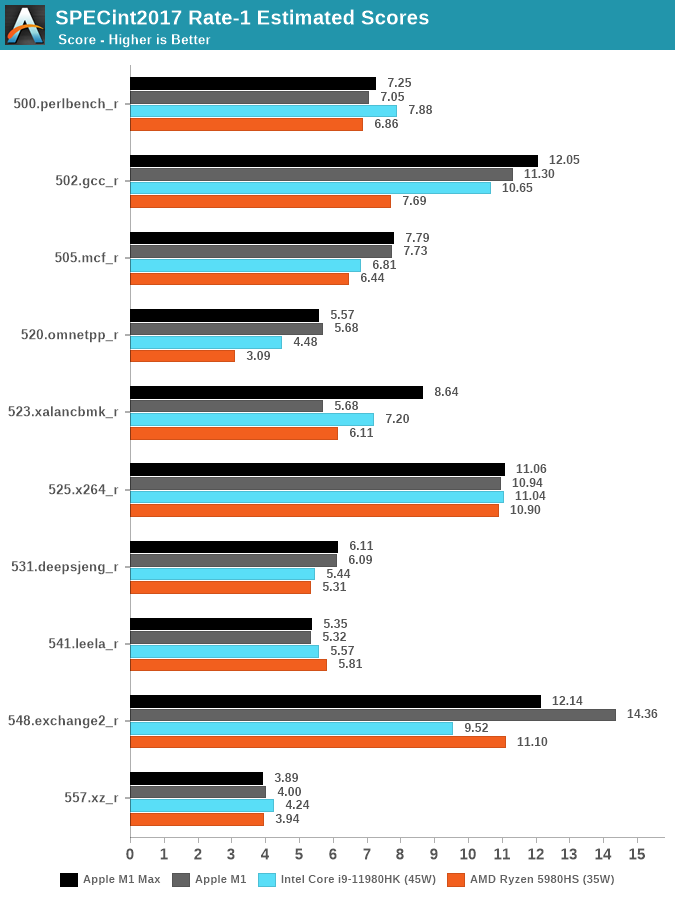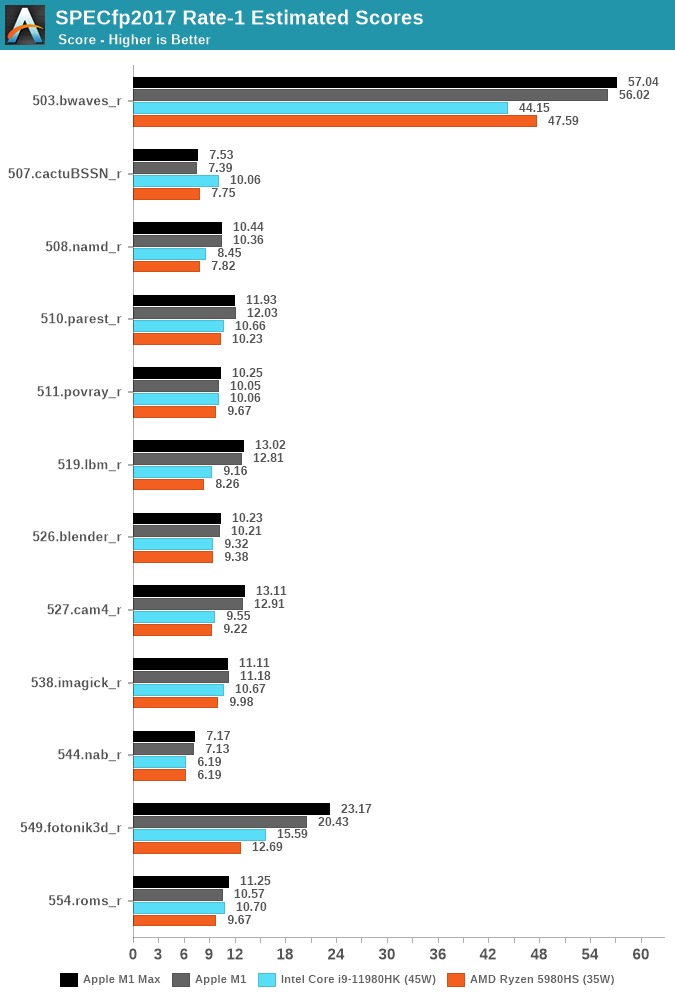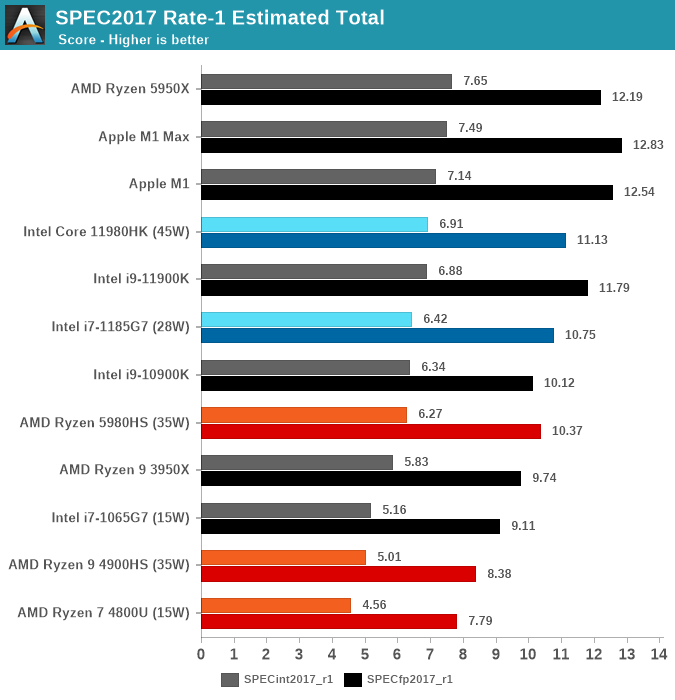Apple's M1 Pro, M1 Max SoCs Investigated: New Performance and Efficiency Heights
by Andrei Frumusanu on October 25, 2021 9:00 AM EST- Posted in
- Laptops
- Apple
- MacBook
- Apple M1 Pro
- Apple M1 Max
CPU ST Performance: Not Much Change from M1
Apple didn’t talk much about core performance of the new M1 Pro and Max, and this is likely because it hasn’t really changed all that much compared to the M1. We’re still seeing the same Firestrom performance cores, and they’re still clocked at 3.23GHz. The new chip has more caches, and more DRAM bandwidth, but under ST scenarios we’re not expecting large differences.
When we first tested the M1 last year, we had compiled SPEC under Apple’s Xcode compiler, and we lacked a Fortran compiler. We’ve moved onto a vanilla LLVM11 toolchain and making use of GFortran (GCC11) for the numbers published here, allowing us more apple-to-apples comparisons. The figures don’t change much for the C/C++ workloads, but we get a more complete set of figures for the suite due to the Fortran workloads. We keep flags very simple at just “-Ofast” and nothing else.

In SPECint2017, the differences to the M1 are small. 523.xalancbmk is showcasing a large performance improvement, however I don’t think this is due to changes on the chip, but rather a change in Apple’s memory allocator in macOS 12. Unfortunately, we no longer have an M1 device available to us, so these are still older figures from earlier in the year on macOS 11.
Against the competition, the M1 Max either has a significant performance lead, or is able to at least reach parity with the best AMD and Intel have to offer. The chip however doesn’t change the landscape all too much.

SPECfp2017 also doesn’t change dramatically, 549.fotonik3d does score quite a bit better than the M1, which could be tied to the more available DRAM bandwidth as this workloads puts extreme stress on the memory subsystem, but otherwise the scores change quite little compared to the M1, which is still on average quite ahead of the laptop competition.

The M1 Max lands as the top performing laptop chip in SPECint2017, just shy of being the best CPU overall which still goes to the 5950X, but is able to take and maintain the crown from the M1 in the FP suite.
Overall, the new M1 Max doesn’t deliver any large surprises on single-threaded performance metrics, which is also something we didn’t expect the chip to achieve.










493 Comments
View All Comments
JfromImaginstuff - Monday, October 25, 2021 - link
Huh, niceKangal - Monday, October 25, 2021 - link
What isn't nice is gaming on macOS.We all know how bad emulation is, and whilst Apple seems to have pulled "magic" with their implementation of Metal/Rosetta2's hybrid-translation strong performance.... at the end of the day it isn't enough.
The M1X is slightly slower than the RTX-3080, at least on-paper and in synthetic benchmarks. This is the sort of hardware that we've been denied for the past 3 years. Should be great. It isn't. When it comes to the actual Gaming Performance, the M1X is slightly slower than the RTX-3060. A massive downgrade.
The silver lining is that developers will get excited, and we might see some AAA-ports over to the macOS system. Even if it's the top-100 games (non-exclusives), and if they get ported over natively, it should create a shock. We might see designers then developing games for PS5, XSX, OSX and Windows. And maybe SteamOS too. And in such a scenario, we can see native-coded games tapping into the proper M1X hardware, and show impressive performance.
The same applies for professional programs for content creators.
at_clucks - Monday, October 25, 2021 - link
"The silver lining is that developers will get excited, and we might see some AAA-ports over to the macOS"I think that's their whole point. Make developers optimize for Mac knowing that gamers would very likely choose to have their performant gaming machine in a Mac format (light, cool, low power) rather than in a hot and heavy DTR format if they had the choice of natively optimized games.
bernstein - Monday, October 25, 2021 - link
we now have 3 primary gpu api‘s:- directx (xbox, windows)
- vulkan (ps5, switch, steamos, android)
- metal (macos, ios & derivates)
Because they’re all low level & similar, most bigger engines support them all.
There used to be two for pc, one for mobile and three for consoles. And vastly different ones at that.
So it will come down to the addressable market and how fast apple evolves the api‘s. Historically windows, with its build once run two decades later has made it much much easier on devs.
yetanotherhuman - Tuesday, October 26, 2021 - link
"how fast apple evolves the api‘s"That'll be a very slow, given their history. Why they invented another API, I have no idea. Vulkan could easily be universal. It runs on Windows, which you didn't note, with great results.
Dribble - Tuesday, October 26, 2021 - link
Vulkan is too low level, it assumes nothing which means you have to right a ton of code to get to the level of Metal which assumes you have an apple device. If metal/dx are like writing in assembly language, for vulkan you start of with just machine code and have to write your own assembler first. Hence it's not really a great language to work with, if you were working with apple then metal is so much nicer.Gracemont - Wednesday, October 27, 2021 - link
Vulkan is too low level? It’s literally comparable to DX12. Like bruh, if anything the Metal API is even more low level for Apple devices cuz of it being built specifically for Apple devices. Just like how the NVAPI for the Switch is the lowest level API for that system cuz it was specifically tailored for that system, not Vulkan.Ppietra - Wednesday, October 27, 2021 - link
Gracemont, the Metal API was already being used with Intel and AMD GPUs, so not exactly a measure of "low level"NPPraxis - Tuesday, October 26, 2021 - link
"Why they invented another API, I have no idea. Vulkan could easily be universal."You're misremembering the history. Metal predates Vulkan.
Apple was basically stuck with OpenGL for a long time, which fell further and further behind as DirectX got lower level and faster. That made all of Apple's devices at a huge gaming handicap.
Then Apple invented Metal for iOS in 2014 which gave them a huge performance rendering lead on mobile devices.
They led the Mac languish for a couple years, not even updating the OpenGL version. Macs got worse and worse for games. In 2016, Vulcan came out. People speculated that Apple could adopt it.
In 2017, Apple released Metal 2 which was included in the new MacOS.
Basically, Apple had to pick between unifying MacOS (Metal) with iOS or with Linux gaming (Vulkan). Apple has gotten screwed over before by being reliant on open source third parties that fell further and further behind (OpenGL, web browsers before they helped build WebKit, etc) so it's kind of understandable that they went the Metal-on-MacOS direction since they had already built it for iOS.
I still wish Apple would add support for it (Mac: Metal and Vulkan, Windows: DirectX and Vulkan, Linux: Vulkan only), because it would really help destroy any reason for developers to target DirectX first, but I understand that they really want to push devs to Metal to make porting to iOS easier.
Eric S - Friday, October 29, 2021 - link
Everyone has their own graphics stack- Microsoft, Sony, Apple, and Nintendo all have proprietary stacks. Vulcan wants to change that, but that doesn’t solve everything. Developers still need to optimize for differences in GPUs. Apple is looking for full vertical integration which helps to have their own stack.